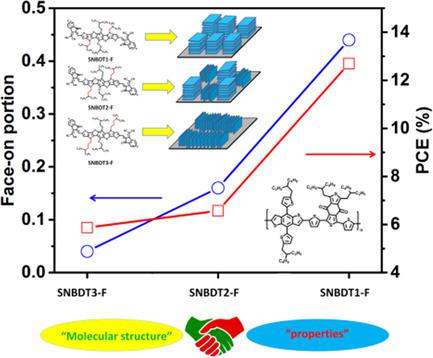Our official English website, www.x-mol.net, welcomes your
feedback! (Note: you will need to create a separate account there.)
Significantly Increasing the Power Conversion Efficiency by Controlling the Orientation of Nonfullerene Small Molecular Acceptors via Side Chain Engineering
Solar RRL ( IF 6.0 ) Pub Date : 2020-05-27 , DOI: 10.1002/solr.202000234 Guang Zeng 1, 2, 3 , Yue Xin 1, 2, 4 , Bo Zhang 1, 2, 4 , Jinyang Ouyang 1, 2, 3 , Xiaoli Zhao 1, 2 , Xiaoniu Yang 1, 2
Solar RRL ( IF 6.0 ) Pub Date : 2020-05-27 , DOI: 10.1002/solr.202000234 Guang Zeng 1, 2, 3 , Yue Xin 1, 2, 4 , Bo Zhang 1, 2, 4 , Jinyang Ouyang 1, 2, 3 , Xiaoli Zhao 1, 2 , Xiaoniu Yang 1, 2
Affiliation

|
Three S,N‐heteroacene nonfullenere small molecular acceptors (NF‐SMAs) with different branching positions on side chains named SNBDT1‐F, SNBDT2‐F, and SNBDT3‐F are synthesized to understand the relationship among branching positions, molecular orientations of NF‐SMAs, and photovoltaic performance of nonfullerene organic solar cells (OSCs). When the branching position is moved close to the conjugated backbone, the proportion of face‐on orientation increases gradually from 4% (SNBDT3‐F), 16% (SNBDT2‐F), to 44% (SNBDT1‐F), suggesting that the molecular orientation changes from edge‐on to face‐on, which has a positive influence on exciton dissociation and charge transport. As a result, the device based on PBDB‐T:SNBDT1‐F shows the highest exciton dissociation probability and carrier mobilities due to the highest proportion of face‐on orientation of SNBDT1‐F. Therefore, the highest power conversion efficiency (PCE) of 12.70% with a high short‐circuit current (Jsc) of 20.97 mA cm−2 and a fill factor of 70.4% is obtained for SNBDT1‐F‐based device, which is much higher than PCEs of SNBDT2‐F‐based (6.57%) and SNBDT3‐F‐based devices (5.87%). Overall, these results provide deep insight into the relationship among the branching positions, molecular orientation, and photovoltaic performance in nonfullerene OSCs, which is important for designing new NF‐SMAs with face‐on orientation and promoting the development of nonfullerene OSCs.
中文翻译:

通过侧链工程控制非富勒烯小分子受体的取向,显着提高功率转换效率
合成了三个在侧链上具有不同分支位置的S,N-杂并苯非富勒烯小分子受体(NF-SMAs),称为SNBDT1-F,SNBDT2-F和SNBDT3-F,以了解分支位置与NF-分子取向之间的关系。 SMA和非富勒烯有机太阳能电池(OSC)的光伏性能。当分支位置移近共轭主链时,面对取向的比例逐渐从4%(SNBDT3-F),16%(SNBDT2-F)增至44%(SNBDT1-F),表明分子取向从边到边都发生变化,这对激子解离和电荷传输有积极影响。结果,基于PBDB-T的设备:由于SNBDT1-F面对面定向的比例最高,因此SNBDT1-F显示出最高的激子解离概率和载流子迁移率。因此,在短路电流较高的情况下,最高功率转换效率(PCE)为12.70%(对于基于SNBDT1-F的设备,J sc)为20.97 mA cm -2,填充系数为70.4%,远高于基于SNBDT2-F的PCE(6.57%)和基于SNBDT3-F的设备的PCE( 5.87%)。总体而言,这些结果为非富勒烯OSC中的支化位置,分子取向和光伏性能之间的关系提供了深刻的洞察力,这对于设计面对面取向的新型NF-SMA和促进非富勒烯OSC的发展非常重要。
更新日期:2020-05-27
中文翻译:

通过侧链工程控制非富勒烯小分子受体的取向,显着提高功率转换效率
合成了三个在侧链上具有不同分支位置的S,N-杂并苯非富勒烯小分子受体(NF-SMAs),称为SNBDT1-F,SNBDT2-F和SNBDT3-F,以了解分支位置与NF-分子取向之间的关系。 SMA和非富勒烯有机太阳能电池(OSC)的光伏性能。当分支位置移近共轭主链时,面对取向的比例逐渐从4%(SNBDT3-F),16%(SNBDT2-F)增至44%(SNBDT1-F),表明分子取向从边到边都发生变化,这对激子解离和电荷传输有积极影响。结果,基于PBDB-T的设备:由于SNBDT1-F面对面定向的比例最高,因此SNBDT1-F显示出最高的激子解离概率和载流子迁移率。因此,在短路电流较高的情况下,最高功率转换效率(PCE)为12.70%(对于基于SNBDT1-F的设备,J sc)为20.97 mA cm -2,填充系数为70.4%,远高于基于SNBDT2-F的PCE(6.57%)和基于SNBDT3-F的设备的PCE( 5.87%)。总体而言,这些结果为非富勒烯OSC中的支化位置,分子取向和光伏性能之间的关系提供了深刻的洞察力,这对于设计面对面取向的新型NF-SMA和促进非富勒烯OSC的发展非常重要。











































 京公网安备 11010802027423号
京公网安备 11010802027423号